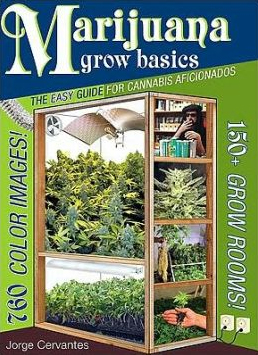
by Jorge Cervantes
Pests and Disease
This section covers the most common pests and diseases that attack plants in a grow room. The descriptions and methods of control are simple and straightforward.
Spider Mites
Spider mites are common indoors. Find spider mites on leaf undersides, sucking plant fluids. They look like tiny specks and cause yellowish-white spots on the tops of leaves. If infested, spider webs may be seen when misted with water. A 10X-30X magnifying glass helps to identify the yellow, white, two spotted, brown, or red mites and their translucent eggs.
Control spider mites by: cleaning up regularly, raising humidity and lowering temperature, smearing Tanglefoot around the pot lip and stems, dipping small plants and spraying large ones with pyrethrum or neem oil, or introducing predatory mites.
Whiteflies
Whiteflies flutter from under leaves when disturbed. They look like a small, white moth about one millimeter long. Adults have wings. Eggs are also found on leaf undersides. Whiteflies cause whitish speckles, stipples, on the tops of leaves.
Attract and kill adults with bright yellow sticky traps that are placed among plants. The wasp Encarsia formosa is the most effective whitefly parasite. Kill with insecticidal soap or pyrethrum applied at five t ten day intervals.
Fungus Gnats
Dark specks are fungus gnats. Larvae grow four to five millimeters long with translucent bodies and black heads. Winged adults are gray to black with long legs. Pests infest growing mediums and roots, eating and scarring roots. Plants loose vigor, foliage pales, and wounds invite disease.
Control with Vectobac, Gnatrol and Bt-i. use neem or insecticidal soap as a soil drench. Predatory soil mites are also available.
Gray Mold (Botrytis)
Gray mold (aka bud mold) flourishes in moist, temperate climates and can be fatal. Botrytis appears hairlike, similar to laundry lint, and later turns slimy but can appear as dark, brownish spots on stems and flowers in arid climates. It attacks stems, leaves, and seeds, and can cause damping-off.
Once it starts, gray mold is fatal. If on buds, cut buds off one inch below infestation. Prevent gray mold by increasing air circulation and ventilation. Use fresh, clean growing medium. Remove infected foliage with alcohol sterilized pruners, and destroy it. Wash your hands and tools.
Damping Off
Damping-off is fatal. It prevents sprouted seeds from emerging. Seedling and cuttings rot at the soil line. First, the stem loses girth at the soil line, grows dark, and finally falls over.
Once it starts, damping off is fatal. Avoid by controlling growing medium moisture. Dust seeds with fungicide.
Green Algae
Slimy, green algae need nutrients, light, and a moist surface to grow. Algae grow on moist rockwool and other moist growing mediums exposed to light. Algae cause little damage, but attract fungus gnats and other pests and diseases.
Prevent by covering moist-growing mediums to exclude light. Control by adding an algaecide to the nutrient solution.
Downy Mildew
Sometimes called “false mildew”, downy mildew affects vegetative and flowering plants. It appears as whitish-yellow spots on top of leaves, creating pale patches. Grayish mycelium spawn is on leaf undersides, opposite the pale patches.
Control with cleanliness! Use sterile growing medium. Remove and destroy affected plants, not just foliage. Kill with biological Serenade and the Bordeaux mixture (copper sulfate and hydrated lime) is also somewhat effective.
Root Rot
Root rot turns roots dark brown, slows growth, leaves discolor, older foliage and later the entire plant wilts. Root rot is caused by lack of oxygen and soggy substrate.
Prevent root rot by using fresh, sterile growing medium and keeping the garden clean. Keep calcium levels adequate and avoid excess nitrogen. Keep pH above 6.0 in hydroponic units, and use Bio-Fungus or RootShield.

